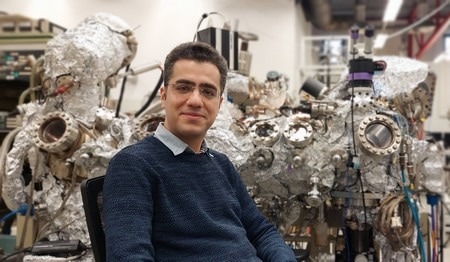Dopamine is best recognized as a neurotransmitter. However, what is less well known is that the underwater glue utilized by mussels has large quantities of L-Dopa molecules, which are an analog of dopamine. Taking this as inspiration, polydopamine coatings have been found that could be employed to activate otherwise inactive surfaces.

Hamoon Hemmatpour. Image Credits: University of Groningen
Many models of polydopamine coatings have been introduced in the past, but now researchers from the University of Groningen have displayed through direct measurements what these coatings actually look like. Their findings were published in the journal Nature Communications on February 7th, 2023.
Polydopamine coatings exhibit great potential: they do not need any solvents apart from water, and they are biocompatible. Being versatile coatings, they adhere to most surfaces and are valuable as intermediate layers, for instance, on inactive surfaces like polyolefins.
Yet until now, we did not understand their exact composition and the way in which they form.
Hamoon Hemmatpour, Postdoc Researcher, Product Technology Group, University of Groningen Engineering and Technology Institute
Building Blocks
To address this gap, Hemmatpour set off to analyze the coatings’ formation: “On the macroscopic scale, this coating forms very quickly, too fast to study intermediates that might reveal what is happening,” he describes.
Therefore, for the coating, he employed nanosized tubes as substrate from a clay mineral. Intermediates from the solution are attracted by a large surface area and negative charges in the mineral, thus slowing down the polymerization process. “This allowed us to take samples of the nanotubes during the polymerization process to identify the intermediates,” he added.
Past efforts to define polydopamine coatings employed approaches like mass spectrometry, which show the polymer’s composition but not the accurate chemical structure. By examining intermediates on the nanotubes with X-Ray photoelectron spectroscopy (XPS) and solid state NMR, Hemmatpour was able to reconstruct what occurs in polymerization.
“These techniques show which chemical bonds are present.” When all the data was there, Hemmatpour and his coworkers could reveal the building blocks’ structure in the coatings, and thereby determine their structure.
Buffering Salt
As the buffered solution reaches a pH of 8.5 or higher, dopamine starts getting polymerized. “One thing we noticed is that the buffering salt TRIS became part of the structure, a sizeable part during the first phases of polymerization, and to a lesser degree as the reaction progressed.” The final examination of the process discloses the auto-oxidation of dopamine, which is followed by intramolecular cyclization, crosslinking, and isomerization.
This study discloses the polydopamine coatings’ formation and structure, which enables researchers to adapt the process for varied applications. “We also believe that our use of clay nanotubes could be expanded to the study of other rapid processes. And adapting the nanotubes to increase surface area would allow us to slow down reactions even further,” adds Hemmatpour.
Neurons
There are other interesting observations from this study. In neural cells, dopamine is stored in vesicles with a very low pH, but in neurodegenerative diseases, these vesicles somehow become leaky, and the dopamine accumulates in the cytosol where the pH is higher. There, the dopamine polymerizes into toxic clumps, which eventually kill neurons. Our study offers new insights into this mechanism and the intermediates of this process that can be used to find a way to treat neurodegenerative diseases.
Hamoon Hemmatpour, Postdoc Researcher, Product Technology Group, University of Groningen Engineering and Technology Institute